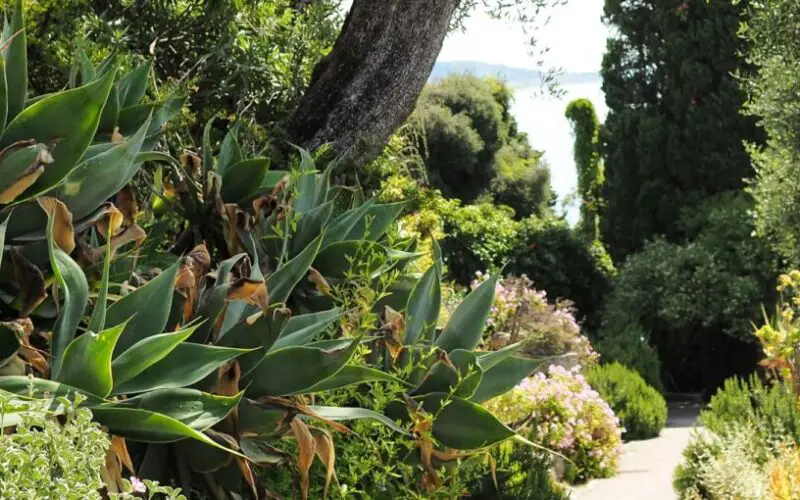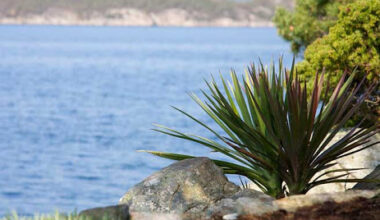You remember with melancholy your vacations in Provence? Do you dream of a pretty little garden that requires very little care and that can withstand the heat waves?
A Mediterranean garden combines the advantage of requiring very little watering and instantly immerses you in a vacation atmosphere. It is easy to create a garden that is bursting with color, has an intoxicating scent and is easy to maintain.
Contents
Conditions for a Mediterranean garden
A Mediterranean garden is composed of carefree plants that require little maintenance once they are well established. A sloping garden with well-drained and not too rich soil will be ideal for the establishment of such plants.
A south-facing exposure will allow the introduction of plants that are not very hardy. Lay out stony areas that will store a maximum of heat during the day and release it throughout the night: the plants will be all the more beautiful.
10 plants to use for a Mediterranean garden
1. Oleander
The oleander, or Nerium oleander, is a very beautiful shrub, naturally present on the Mediterranean rim. It grows quite quickly and takes a bushy habit. Its flowers range from white to dark pink (there are even varieties with yellow flowers! but they are much less common). It has long, elongated and tough evergreen leaves of dark green color. You can cultivate it in hedge, in isolated, or in vat. It is also rather easy to multiply it by cutting.
2. Lavender
Lavender evokes Mediterranean landscapes, mauve-colored fields that stretch as far as the eye can see… We appreciate its very fragrant flowers, gathered in ears of corn, with soft hues. The most common is Lavandula angustifolia, also called True Lavender or Lavender, of which there are also varieties with white flowers, such as Lavandula angustifolia ‘Alba’.
Also discover the butterfly lavender, Lavandula stoechas! Its original flowers have decorative, highly developed bracts. Lavender is melliferous, attracting pollinating insects, and it also has medicinal properties (can be used in essential oil, infusion, etc.). It is notably calming, effective against anxiety, and promotes sleep. In the garden, it likes limestone soils, rather dry.
3. The olive tree
Superb tree with a tortuous trunk, the Olive tree, or Olea europaea, is a true symbol of the Mediterranean. We appreciate its majestic, imposing architecture. It bears long, elongated, silver-gray leaves, and offers in spring small white – creamy yellow flowers, followed by olives, first green, then black when ripe.
It has an exceptional longevity, and forms over time a remarkable trunk that seems to twist on itself, to take an irregular and very large shape, quite unique. If you live in the north of the Loire river, it will be preferable to cultivate it in vats, and to bring it back under shelter for the winter.
4. The cistus
Cistus is a small shrub that is appreciated for its flowers often white or pink (depending on the variety), with many yellow stamens in the center. These flowers are formed of large petals with a crumpled appearance, which sometimes bear beautiful black or purple macules, towards the center of the flower, which brings more intensity.
The flowers are very ephemeral, but follow one another without stop… The leaves of the cistus are persistent, sometimes a little sticky, and of green or grayish color. The ladanifer cistus gives an essential oil, with healing and anti-infectious properties.
5. The agaves
Natives of America (south of the United States, Mexico…), Agaves are impressive plants by their large rosettes of fleshy, thick leaves, finished in point.
Those often have a gray or glaucous, bluish tint, but can also be of a more frank green, and are sometimes variegated of white or yellow cream. Agave americana is one of the most interesting species in cultivation. Agave is a monocarpic plant: it flowers only once in its life and then dies.
However, the bloom can occur after several decades, and it is often impressive, some species producing a gigantic floral scape! Agave is sometimes confused with aloe, which also forms beautiful rosettes of fleshy leaves.
6. Palm trees
Most palm trees are not native to the Mediterranean, but they evoke warm climates, vacations, and have been widely planted on the Mediterranean coast. The true Mediterranean palm is the Chamaerops humilis (as well as the Phoenix theophrastii).
But you can also grow Phoenix canariensis, Trachycarpus, Washingtonia, Butia… Palms have an imposing silhouette, consisting of one or more thick, straight, unbranched trunks. At the top are very large leaves, which may be palmated or pinnate, and are thick, tough, green or bluish in color.
7. The fig tree
Also called Ficus carica, the fig tree is a fruit tree that bears beautiful leaves, quite large, cut into large, rounded lobes. They are deciduous. The fig tree takes an elegant silhouette, and has a trunk with smooth gray bark. Its branches contain a white latex.
This tree produces figs in summer, fleshy fruits that are appreciated for their sweet, sugary flavor, but also have very good nutritional values. In draining soil, it is able to withstand up to 5 °F. It can be multiplied by cutting.
8. The pomegranate tree
The pomegranate tree, Punica granatum, is a small fruit tree, with a bushy habit and dark green, shiny, deciduous foliage. When they appear in spring, the leaves are a beautiful reddish tint, then turn green and then golden in autumn, before disappearing for the winter. It offers beautiful red flowers, which appear between May and July-August, and consist of petals with a crumpled appearance.
They are followed by large rounded fruits, red, orange or yellow. The pomegranate has a long life span, is quite hardy (able to withstand between 5 and 10 °F), and tolerates drought rather well.
9. The arbutus tree
The Arbutus (Arbutus unedo) is an evergreen shrub, dark green and shiny. It produces in early autumn small white bell-shaped flowers and spherical, orange-red fruits with a rough surface. They are edible and give this shrub its nickname of “strawberry tree”! With time, the strawberry tree takes on a very beautiful silhouette, with twisted branches and a reddish bark that peels off and comes off in strips. It is found naturally around the Mediterranean Basin.
10. The cypress of Provence
The Cypress of Provence, or Cupressus sempervirens, is a conifer with a columnar port, very straight, and dark green foliage. With its erect growth habit, and being able to reach 30 – 35 m in height, it constitutes a structuring element in a garden. You can plant it near the entrance of your house, or in line to border a path. It is very rustic, supports the wind, and is able to live several hundred years!
Decorating a Mediterranean garden
Large terracotta jars full of ivy geraniums, dry stone walls forming benches to install feet of agapanthus and lavender, a ceramic cicada against the wall of the house and the whole Provence invites itself into your garden!
Summary
You dream of reproducing at home the charm of the Provençal gardens in order to enjoy the typical atmosphere and the sweet smells of your vacations without moving from home… Dare the Mediterranean garden!









